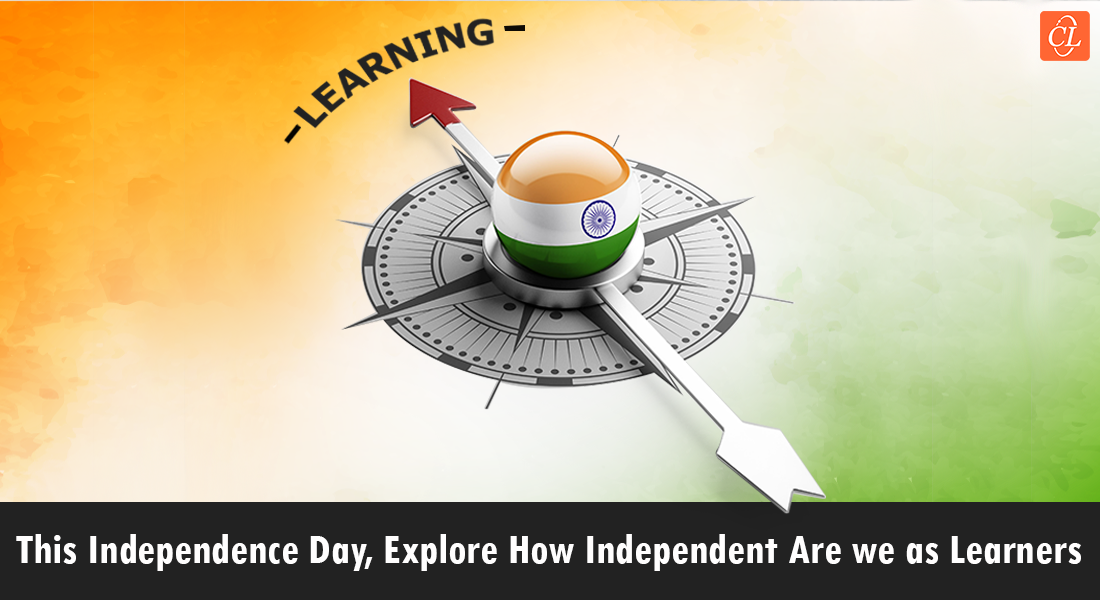Break Free from Corporate Training Monotony This 75 Indian Independence Day

The day when an ancient civilization became a modern country is indelibly carved into history and the collective consciousness of the people as the day that India attained independence is commemorated as India’s Independence Day every year on August 15. The South Asian nation gained independence on this day, exactly 75 years ago, after shedding the shackles of colonialism. India has been able to provide possibilities for its billion+ residents to accomplish, advance, and flourish during the past 75 years by using its civilizational assets and cultural variety.
→ Download eBook- Making a Business Case for eLearning [eBook]
India has made significant advances in many economic sectors during the past seven decades, including agriculture, industrial plants, energy, communications, and others. The country’s economy liberalized, and it became a major participant in the international IT sector during the last decade of the 20th century. The country is currently one of the largest global knowledge economies.
Wondering How to Break Free from Corporate Training Monotony This 75th Indian Independence Day?
Here Are the Top 3 New Age Learning Frameworks and Methodologies to Get You Started:
- Microlearning
- Holistic Learning Solutions Based on the 55:20:20 Model
- Virtual Instructor-Led Training (VILT)
India’s enormous pool of smart, highly skilled workers is a major reason for the country’s rise as a powerhouse in the information age. Our nation’s educational system has undergone several dramatic changes in recent years, giving our youth the information and abilities, they need to prosper in the modern era. The rapid expansion of eLearning is one of these revolutionary advances.
Change is necessary, unavoidable, and significant. It is essential for advancement and natural growth. Do you realize that the legacy of corporate training is still being rewritten today? Newer, online training methodologies that provide flexibility, rapid access, and more are opening up as a result of shifting learner preferences, global challenges, and significant events. The benefits of eLearning for business training are well known.
On the other hand, let’s look at how technology-enabled training could indeed help the nation’s educational system be prepared to meet the demands of the modern economy in the event of the country’s Independence Day. Additionally, how online training can assist with workplace training by maintaining the speed of change through new-age learning strategies and smarter technology.
How eLearning Is Assisting the Indian Education System in Forming the Country’s Economy
1. Assisting with the Solutions to “Out-Of-Date” Content Issues
Unfortunately, the curriculum of most programs provided by higher education institutions in India cannot be adjusted to match the demands of the business world. Many of the nation’s higher education institutions still use obsolete curricula, which harms graduates’ ability to find employment since they lack the skills and knowledge that businesses need.
Online learning courses might help you tackle this issue. For instance, the web-based learning format may be used to teach coding skills to information and technology grads in an economical manner. An engineering institution pushes its students to get Microsoft, Oracle, and C++ Institute certifications since they are highly appreciated by the business world.
2. Upskilling and Reskilling Millions of Rural Indians
India is reported to have a large rural population. Many influential leaders in the nation’s independence struggle had the view that providing the rural masses of the country with quality education would greatly boost the country’s economy and raise their standard of life. Numerous programs have been started since 1947 to improve the quality of education provided to people in India’s rural communities.
The development of the digital world has accelerated attempts to provide quality education to the nation’s rural population. The growing usage of smartphones in rural India has created new opportunities for the dissemination of information and skills. To educate rural youngsters, some states in the nation are using mobile learning (m-learning). To provide the skills required for rural and agro-based enterprises, the state of Andhra Pradesh, for example, has started a huge m-learning initiative. The state is using the potential of video-based modules to instruct learners in cutting-edge poultry farming and dairy processing technology.
Do you want to create engaging e-learning courses? Here is a detailed roadmap to assist you on your journey.
Now that we understand how eLearning supports India’s education sector in influencing the country’s economy, Let’s look at how online training keeps up with the rapid pace of change in corporate training with better technologies and cutting-edge learning techniques.
New-age Learning Framework And Strategies for Corporate Training
Even while eLearning has a substantial market value, it still has a lot of untapped potentials. Researchers have nevertheless introduced several excellent formats that businesses might choose based on the kind of training they are delivering.
1. Microlearning
Because it appeals to their creative inclination, millennials tend to listen to their hearts and appreciate short bits. But it becomes more difficult to captivate and hold their interest. Do you anticipate that the world of 15-second tales and 30-second clips will eclipse your drawn-out, tedious online training courses? As a manager of training, do you have trouble maintaining high engagement levels and reinforcing training? These issues can all be solved through microlearning. Give learners information in “bite-sized” chunks that are interesting and concentrate on knowledge that they need to know. These simple-to-revisit micro assets significantly contribute to the reinforcement of performance-based learning goals, even when learners’ minds are overloaded with information. Adding microlearning to workplace training may be done in several simple methods, including:
- Short clips of video to greet recruits or indicate changes
- Software use simulations for training or testing
- Scenarios that act as a hands-on learning tool, either quiz or standalone
- Quizzes and games for assessments
- Infographics that demonstrate the dos and don’ts

eLearning Trends for 2024
Seal the Deal with Success
- Training Formats for Upskilling and Reskilling
- Popular AI Tools for L&D
- Mastering the New-Age Learning Formats
- And More!
2. Holistic Learning Solutions Based on the 55:20:20 Model
Our feeling of safety is enhanced by freedom. This enables us to investigate and evaluate the data we depend on, and think is accurate. The 70:20:10 paradigm, which serves as the foundation for many choices on learning and development, must be reconsidered. Let’s examine how the globe might benefit from the flexibility that blended learning offers in light of fresh facts, particularly in light of the present epidemic. Let’s explore blended learning tactics from the perspective of online learning. Simulators, immersive courses, and scenario-based eLearning may all be used to deliver experiential learning (55%) by letting learners learn by doing. You may encourage social learning (25%) via your social media platforms, user-generated material, webinars, and other methods. Curriculums for online learning and virtual instructor-led training may be used to provide formal education (20%).
3. Virtual Instructor-Led Training (VILT)
We are no longer completely free because of the growing epidemic. Human connection has been restricted, and we are now isolated inside the four walls of our homes. This has had a significant influence on employment, society, and corporate training. Virtual instructor-led training is one technique to handle this dire situation. It may be used to augment face-to-face engagement in online instruction and to enable ongoing communication among learners to boost morale. We can simulate classroom interaction in VILT with the help of fantastic technologies. Here are a few quick methods for doing so:
Use chats to allow instructors and learners to converse informally, simulating our coffee break gatherings. polls to get comments and thoughts. Learners may express their selections and learn about those of their classmates via annotations.
Breakout rooms are yet another fantastic technique to encourage social learning and imitate the peer-to-peer contact and cooperation offered by the classroom. They are mini virtual spaces where learning communities may convene to talk, exchange ideas, or take part in group activities.
Parting Thoughts
We wish you a belated happy 75th year of independence! I hope you had a day full of thankfulness, glory, and hope. Let us take a comprehensive view of the eLearning trends 2022 has to offer as we all progress toward growth. With half of the year completed, let us beautifully connect the second part of the year with progress. Check out our eBook for a perspective from the front lines. Now there is only one direction to go: up!
Wish you a very Happy Independence Day!





